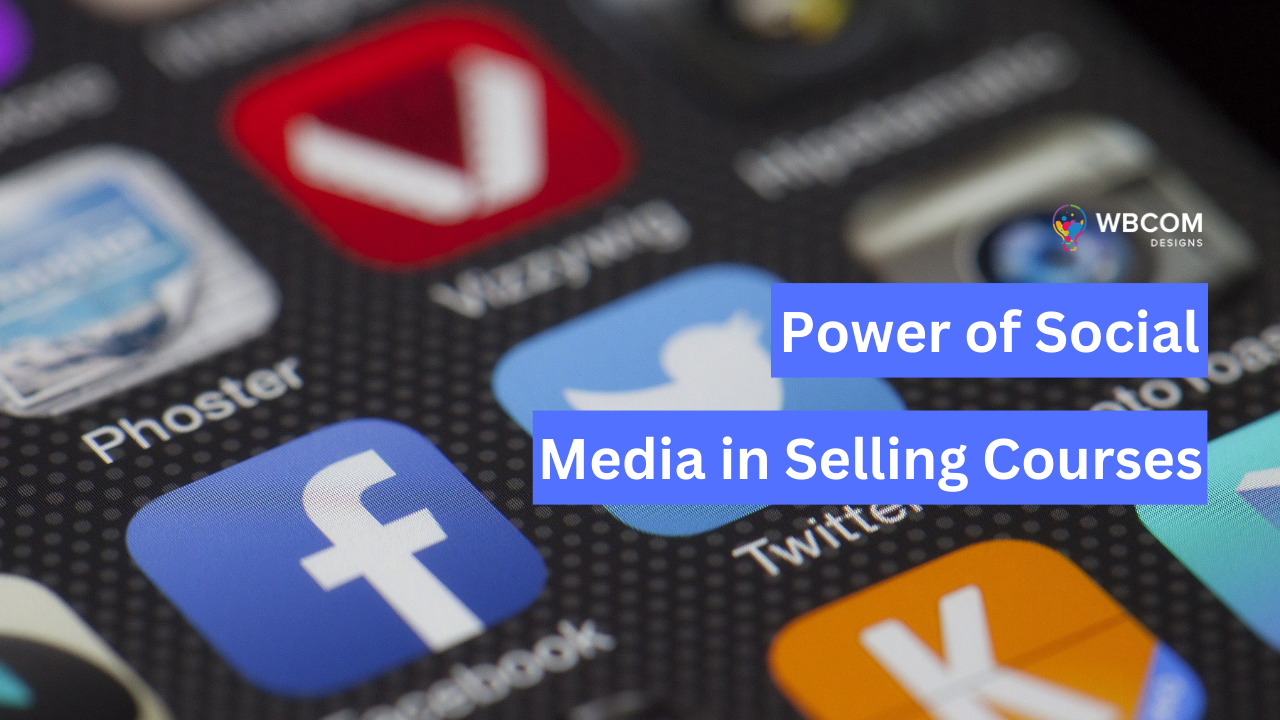Are you tired of struggling to sell your courses? Do you feel your content goes unnoticed in a sea of online information? Well, it’s time to take advantage of the most powerful tool: social media. With billions of active users across various platforms, social media has become a game-changer for businesses and entrepreneurs. In this blog post, we’ll dive into the power of social media in selling courses, exploring the various ways you can leverage its potential to grow your business and reach your target audience like never before. From building your brand to establishing credibility and driving sales, social media is the key to unlocking your course’s full potential. So, grab your phone, log in to your accounts, and get ready to discover the true power of social media in selling your courses.
Table of Contents
ToggleUnderstanding Social Media Platforms
Social media has become an integral part of promoting and selling online courses. With billions of active users on various platforms, social media provides a vast audience for course creators to showcase their content and grow their businesses. In this section, we’ll discuss some of the most popular social media platforms and how they can be used to promote and sell online courses.

Facebook is one of the most widely used social media platforms, with over 2.7 billion active users. It offers various features like groups, pages, and events, which can be leveraged to promote courses. Pages are ideal for building a brand and sharing updates with followers, while groups can be used to build an online community around your course. Facebook events can be used to promote webinars or course launches and are an excellent way to reach a wider audience.
Twitter has over 330 million active users and is known for its real-time communication. Course creators can use Twitter to share updates, promote content, and engage with followers. Hashtags are a great way to reach a wider audience, and Twitter’s retweet feature can help content go viral.

Instagram has over 1 billion active users, and its visual nature makes it an excellent platform for promoting online courses. Course creators can use Instagram to showcase their content through pictures and videos, and Instagram stories can be used to share updates or behind-the-scenes content.
LinkedIn is a professional networking platform with over 740 million active users. It is ideal for promoting B2B courses or targeting a professional audience. LinkedIn allows course creators to share updates and content, connect with other professionals, and participate in groups.
TikTok
TikTok is a video-sharing platform with over 800 million active users. It is known for its short-form videos and has become popular among younger audiences. Course creators can use TikTok to share short educational videos, engage with followers, and reach a wider audience.
Selecting the right platforms for your course depends on your target audience and content. It is essential to understand where your audience spends their time and what type of content they engage with. For example, if your target audience is primarily professionals, LinkedIn may be the best platform to reach them. Conversely, if your course is geared toward a younger audience, TikTok may be a better fit.
Each platform has its unique features and advantages. Facebook’s groups and events are ideal for building communities and promoting webinars, while Twitter’s real-time communication can help content go viral. Instagram’s visual nature makes it great for showcasing content, while LinkedIn’s professional network can help establish credibility. TikTok’s short-form videos can be used to create engaging and educational content.
How to Create a Social Media Strategy?
Having a social media strategy is crucial for effective course promotion and sales. A well-defined strategy will help course creators to achieve their marketing objectives, reach their target audience, and generate engagement and conversions. In this section, we’ll discuss the importance of a social media strategy, how to develop one and provide examples of content types and best practices for each platform.
Importance of a Social Media Strategy
A social media strategy helps course creators to:
- Define their marketing goals and objectives
- Identify their target audience
- Choose the most appropriate social media platforms
- Create engaging and relevant content
- Monitor their performance and adjust their approach accordingly
Developing a Social Media Strategy

To develop a social media strategy, course creators should follow these steps:
- Step 1: Set goals and objectives – This could include increasing course enrollments, generating leads, or improving engagement on social media.
- Step 2: Identify key performance indicators (KPIs) – Examples include social media followers, engagement rates, click-through rates, and conversion rates.
- Step 3: Identify target audience – Determine who your ideal students are and what social media platforms they use.
- Step 4: Choose the right social media platforms that align with your target audience and goals.
- Step 5: Develop a content calendar – Create a schedule for when and what content will be posted.
Social Media Content Types and Best Practices for Each Platform
a) Facebook
- Content types: Text updates, images, videos, polls, events, groups
- Best practices: Use visuals, tag relevant pages or people, use hashtags, post at optimal times, engage with followers in comments, and use Facebook ads for promotions
b) Twitter
- Content types: Text updates, images, videos, polls, threads
- Best practices: Use hashtags, tag relevant people or pages, use Twitter lists to organize content, engage with followers in replies and direct messages, use Twitter ads for promotions
c) Instagram
- Content types: Images, videos, stories, reels, IGTV
- Best practices: Use high-quality visuals, use hashtags and location tags, post consistently, engage with followers in comments and direct messages, use Instagram ads for promotions
d) LinkedIn
- Content types: Text updates, articles, videos, images, polls, events
- Best practices: Use a professional tone, share industry insights, join and engage in relevant groups, use LinkedIn ads for promotions, use LinkedIn Learning to create and promote courses
e) TikTok
- Content types: Short-form videos, challenges, trends, duets
- Best practices: Use creative and engaging visuals, participate in trends and challenges, use popular music, use relevant hashtags, engage with followers in comments, and use TikTok ads for promotions.
How to Build a Social Media Following?

Building a social media following is essential for course creators who want to increase their sales and grow their brands. A strong following can help course creators to generate more leads, create a community of engaged students, and increase brand awareness. In this section, we’ll discuss the importance of building a social media following, provide tips for growing your following, and highlight the importance of authenticity and transparency in building a following.
Importance of Building a Social Media Following
Building a social media following can help course creators:
- Increase brand visibility and awareness
- Generate leads and conversions
- Create a community of engaged students
- Establish thought leadership in their industry
- Gain valuable feedback and insights from their audience
Tips for Growing Your Social Media Following
Here are some tips for growing your social media following:
a) Create valuable content – Create informative, engaging, and relevant content to your target audience. This will help you to establish yourself as an expert in your industry and attract more followers.
b) Engage with your audience – Respond to comments and messages, participate in discussions, and ask for feedback. This will help you to build relationships with your followers and create a sense of community.
c) Run social media ads – Social media ads can help you to reach a wider audience and increase your following. Target your ads to your ideal students and use compelling visuals and messaging to attract their attention.
d) Collaborate with influencers – Partner with influencers in your industry with a large following. This can help you to reach new audiences and gain more followers.
e) Use hashtags – Use relevant hashtags in your posts to help your content get discovered by people who are interested in your industry.
Importance of Authenticity and Transparency
In building a social media following, authenticity and transparency are critical. Course creators should be transparent about who they are and what they stand for and be authentic in their messaging and interactions with their audience. This can help build trust and credibility with followers, increasing engagement and conversions.
How to Leverage Social Media Advertising?
Social media advertising has become essential for course creators who want to increase their course sales and reach a wider audience. In this section, we’ll discuss the advantages of social media advertising, provide tips for creating effective ads, and highlight how to develop effective retargeting campaigns.
Advantages of Social Media Advertising
Social media advertising offers several advantages for course creators, including:
a) Targeted audience – Social media platforms have powerful targeting capabilities that allow course creators to reach their ideal students based on demographics, interests, and behaviors.
b) Cost-effective – Social media advertising is generally more cost effective than traditional advertising methods, as course creators can set their budget and only pay for clicks or impressions.
c) Increased brand awareness – Social media ads can help increase brand awareness and exposure, especially for course creators just starting out.
d) Higher conversion rates – Social media ads can lead to higher conversion rates, as they allow course creators to reach potential customers who are already interested in their course topic.
Tips for Creating Effective Social Media Ads
Here are some tips for creating effective social media ads:
a) Use compelling visuals and copy – Use eye-catching visuals and copy that speaks directly to your target audience. This will help your ad stand out and attract more clicks.
b) Target the right audience – Use targeting options to ensure your ads are shown to the right audience. This will help increase your ads’ relevance and improve their performance.
c) A/B test your ads – Test different ad creatives and targeting options to see what works best for your audience. This will help you to optimize your ads for better performance.
d) Track ad performance – Use social media advertising analytics to track the performance of your ads. This will help you understand what’s working and what’s not and adjust accordingly.
Creating Effective Retargeting Campaigns
Retargeting campaigns allow course creators to reach potential customers who have interacted with their course content by visiting their website or social media profiles. Here’s how to create an effective retargeting campaign:
a) Set up tracking pixels – Use tracking pixels to track website visitors and social media engagement.
b) Create custom audiences – Use tracking data to create custom audiences based on website visits or social media engagement.
c) Develop retargeting ad creatives – Create ad creatives that speak directly to potential customers who have already interacted with your course content.
d) A/B test your retargeting ads – Test different ad creatives and targeting options to see what works best for your audience.
How to Engage with Your Social Media Audience?
Engaging with your social media audience is crucial to building relationships and increasing course sales. In this post, we’ll discuss the importance of engaging with your audience, provide tips for engaging with them effectively, and highlight how engagement can help drive word-of-mouth marketing and course sales.
Importance of Engaging with Your Social Media Audience
Engaging with your social media audience is vital for several reasons, including:
a) Building relationships – Engaging with your audience helps build trust and rapport with them, leading to increased loyalty and sales.
b) Creating a community – Engaging with your audience can help create a sense of community around your course, leading to increased engagement and course sales.
c) Providing personalized support – Engaging with your audience allows you to provide customized support and assistance, which can lead to increased satisfaction and referrals.
Tips for Engaging with Your Audience
Here are some tips for engaging with your audience effectively:
a) Respond to comments and messages – Respond promptly to comments and messages from your audience, and be sure to address any questions or concerns they may have.
b) Create a community – Encourage your audience to engage with each other by creating a community around your course, such as a Facebook group or forum.
c) Offer personalized support – Provide customized support to your audience by offering one-on-one coaching or consulting services.
d) Share user-generated content – Share user-generated content from your audience, such as testimonials or success stories, to show that you value and appreciate their support.
Using Engagement to Drive Word-of-Mouth Marketing and Course Sales
Engagement can also be used to drive word-of-mouth marketing and course sales. Here’s how:
a) Encourage user-generated content – Encourage your audience to share their experiences with your course on social media and share their content with your audience.
b) Offer incentives to customers who refer their friends and family to your course, such as discounts or free access to additional course materials.
c) Host live events – Host live events, such as webinars or Q&A sessions, to engage with your audience and provide additional value.
How to Measure and Analyze Social Media Performance?
Measuring and analyzing social media performance is essential for continuous improvement and success in online course sales. This post will discuss the importance of measuring and analyzing social media performance, key performance indicators (KPIs) to track, and tips for researching your social media data and making data-driven decisions.
Importance of Measuring and Analyzing Social Media Performance
Measuring and analyzing social media performance is crucial for several reasons, including:
a) Understanding audience behavior – Measuring and analyzing social media performance helps you understand your audience behavior, such as what type of content they engage with and when they are most active on social media.
b) Identifying what works and what doesn’t – Analyzing social media data helps you identify what content and campaigns successfully optimize your social media strategy accordingly.
c) Making data-driven decisions – By measuring and analyzing social media data, you can make data-driven decisions about your social media strategy, leading to improved performance and sales.
Key Performance Indicators (KPIs) to Track
Here are some key performance indicators (KPIs) to track when measuring your social media performance:
a) Engagement rate – This measures how much your audience interacts with your content, such as liking, sharing, and commenting.
b) Reach and impressions – This measures the number of people who see your content on social media.
c) Conversion rate – This measures the percentage of people who take a specific action on your social media, such as clicking a link to your course page.
d) Referral traffic – This measures the traffic that comes to your course page from social media.
Tips for Analyzing Your Social Media Data and Making Data-Driven Decisions
Here are some tips for analyzing your social media data and making data-driven decisions:
a) Use analytics tools – Use social media tools like Facebook Insights and Twitter Analytics to track your KPIs and gather data on your social media performance.
b) Compare performance over time – Compare your social media performance to identify trends and make informed decisions about your strategy.
c) Experiment with different types of content – Use social media data to experiment with different content and campaigns to see what works best for your audience.
d) Continuously optimize your social media strategy – Use social media data to continuously optimize your social media strategy, such as by adjusting the timing and frequency of your posts or targeting different audience segments.
Wrapping Up Words | Power of Social Media in Selling Courses
In conclusion, social media has become a powerful tool for selling courses and reaching a wider audience. With the right strategy and approach, you can leverage the power of social media to attract new students, build your brand, and grow your business. So don’t be afraid to dive in, experiment, and see what works best for you. You can succeed in the exciting world of online education with dedication and persistence. Happy selling!







